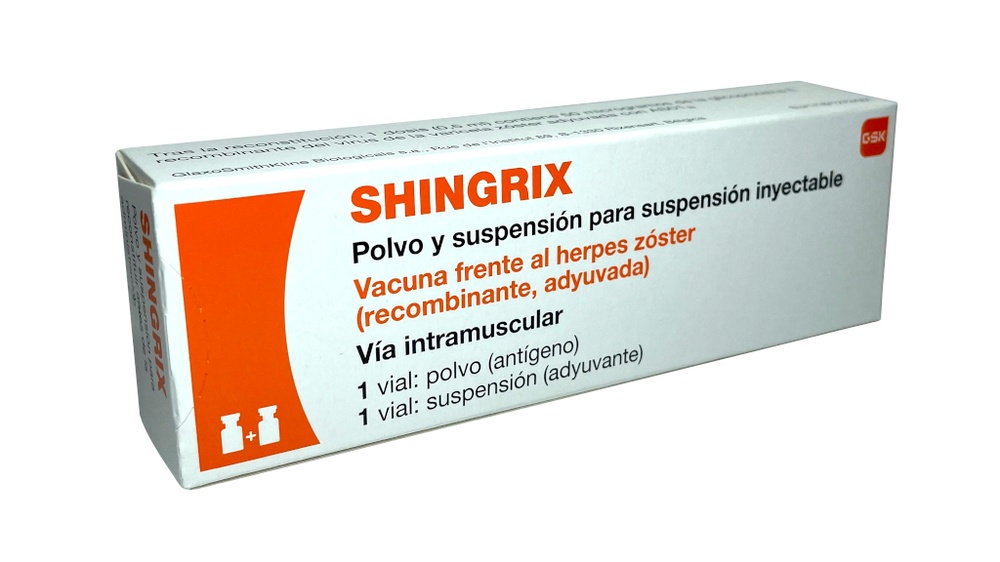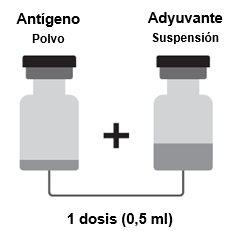

SHINGRIX powder and suspension for injectable suspension

Ask a doctor about a prescription for SHINGRIX powder and suspension for injectable suspension

How to use SHINGRIX powder and suspension for injectable suspension
Introduction
Package Leaflet: Information for the User
Shingrix Powder and Suspension for Suspension for Injection
Herpes Zoster Vaccine (Recombinant, Adjuvanted)
Read all of this leaflet carefully before you start receiving this vaccine because it contains important information for you.
- Keep this leaflet, you may need to read it again.
- If you have any further questions, ask your doctor or pharmacist.
- This medicine has been prescribed for you only. Do not pass it on to others.
- If you experience any side effects, talk to your doctor or pharmacist. This includes any possible side effects not listed in this leaflet. See section 4.
Contents of the Package Leaflet
- What is Shingrix and what is it used for
- What you need to know before you receive Shingrix
- How Shingrix is administered
- Possible side effects
- Storage of Shingrix
- Contents of the pack and other information
1. What is Shingrix and what is it used for
What Shingrix is used for
Shingrix is a vaccine that helps protect adults against herpes zoster (shingles) and postherpetic neuralgia (PHN), the long-lasting pain that follows shingles due to nerve damage.
Shingrix is administered to:
- adults aged 50 years and older;
- adults aged 18 years and older who are at greater risk of getting shingles.
Shingrix cannot be used to prevent chickenpox.
What is herpes zoster
- Herpes zoster is a blistering rash, often painful. It usually occurs in a limited area of the body and can last for several weeks.
- Herpes zoster is caused by the same virus that causes chickenpox.
- After having chickenpox, the virus that caused it remains in your body, in your nerve cells.
- Sometimes, after many years, if your immune system (the body's natural defenses) weakens (due to age, illness, or a medication you are taking), the virus can cause shingles.
Complications related to herpes zoster
Herpes zoster can cause complications.
The most common complication associated with herpes zoster is:
- long-lasting pain due to nerve damage - called postherpetic neuralgia or PHN. After the shingles blisters have gone, you can have pain for months or years and it can be severe.
Other complications of herpes zoster are:
- scarring where there have been blisters
- skin infections, weakness, muscle paralysis, and loss of hearing or vision - these are less common.
How Shingrix works
Shingrix helps your body remember the virus that causes shingles. This helps your immune system (the body's natural defenses) to be prepared to fight the virus and protect you against shingles and its complications.
2. What you need to know before you receive Shingrix
Shingrix must not be administered if
- you are allergic to the active substance or any of the other ingredients of this vaccine (listed in section 6). The signs of an allergic reaction may include: skin rash with itching, difficulty breathing, and swelling of the face or tongue.
Shingrix must not be administered if any of the above applies to you. If you are not sure, consult your doctor or pharmacist.
Warnings and precautions
Consult your doctor or pharmacist before starting to receive Shingrix if:
- you have a severe infection with a high temperature (fever). In these cases, vaccination may need to be postponed until you have recovered. A minor infection, such as a cold, should not be a problem, but consult your doctor first;
- you have a bleeding problem or bruise easily.
If any of the above applies to you (or you are not sure), consult your doctor or pharmacist before you receive Shingrix.
Fainting can occur after any injection, so tell your doctor or nurse if you have fainted after an injection in the past.
Shingrix cannot be used as a treatment if you already have shingles or complications associated with it.
As with all vaccines, it may not fully protect all people who are vaccinated.
Tell your doctor if, after receiving Shingrix, you experience temporary inflammation of the nerves that causes pain, weakness, and paralysis (called Guillain-Barré Syndrome). A slight increase in the risk of Guillain-Barré Syndrome (estimated at 3 additional cases per million doses administered) has been reported after receiving Shingrix in people aged 65 years and older.
Other medicines and Shingrix
Tell your doctor or pharmacist if you are using, have recently used, or might use any other medicines, including medicines obtained without a prescription, or if you have recently been given any other vaccine.
Shingrix can be administered at the same time as other vaccines such as the inactivated, non-adjuvanted seasonal flu vaccine, the 23-valent pneumococcal polysaccharide vaccine, the 13-valent pneumococcal conjugate vaccine, the reduced antigen content diphtheria, tetanus, and pertussis (acellular component) vaccine, or the COVID-19 mRNA vaccine. A different injection site will be used for each vaccine.
You are more likely to experience fever and/or chills when Shingrix is administered at the same time as the 23-valent pneumococcal polysaccharide vaccine.
You are more likely to experience chills, fatigue, fever, stomach and digestive symptoms (including nausea, vomiting, diarrhea, and/or stomach pain), headache, muscle pain, or joint pain when the COVID-19 mRNA vaccine is administered at the same time as Shingrix.
Pregnancy and breastfeeding
If you are pregnant or breastfeeding, think you may be pregnant, or plan to become pregnant, consult your doctor or pharmacist before you receive this vaccine.
Driving and using machines
Some of the effects mentioned in section 4 “Possible side effects” may affect your ability to drive or use machines temporarily. Do not drive or use machines if you do not feel well.
Shingrix contains polysorbate 80, sodium, and potassium
This medicine contains 0.08 mg of polysorbate 80 per dose. Polysorbates may cause allergic reactions. Inform your doctor if you have any known allergy.
This medicine contains less than 1 mmol of sodium (23 mg) per dose; this is essentially “sodium-free”.
This medicine contains potassium, less than 1 mmol (39 mg) per dose; this is essentially “potassium-free”.
3. How Shingrix is administered
- Shingrix is administered by injection into a muscle (usually in the upper arm).
- You will receive 2 injections, 2 months apart. If flexibility in the vaccination schedule is required, the second dose can be administered between 2 and 6 months after the first dose.
Depending on your health status, your doctor may also recommend that you receive the second injection 1 month after the first.
- You will be informed about when you need to return for the second dose of Shingrix.
Make sure you complete the vaccination program. This will maximize the protection offered by Shingrix.
You can receive Shingrix even if you have already been vaccinated with the live attenuated herpes zoster vaccine. For more information, consult your doctor.
4. Possible side effects
Like all medicines, this vaccine can cause side effects, although not everybody gets them.
Side effects reported during clinical trials and after marketing of Shingrix:
Very common(may affect more than 1 in 10 doses of vaccine):
- headache
- stomach and digestive symptoms (including nausea, vomiting, diarrhea, and/or stomach pain)
- muscle pain (myalgia)
- pain, redness, and swelling at the injection site
- feeling tired
- chills
- fever
Common(may affect up to 1 in 10 doses of vaccine):
- itching at the injection site (pruritus)
- general feeling of being unwell
Uncommon(may affect up to 1 in 100 doses of vaccine):
- swelling of the lymph nodes in the neck, armpits, or groin
- joint pain
Rare(may affect up to 1 in 1,000 doses of vaccine):
- allergic reactions including rash, hives, swelling of the face, tongue, or throat that can cause difficulty swallowing or breathing (angioedema)
Most of these side effects are mild to moderate and short-lived.
Immunocompromised adults between 18 and 49 years of age may have more side effects than immunocompromised adults aged 50 years and older.
Adults between 50 and 69 years of age may have more side effects than adults aged 70 years and older.
Reporting of side effects
If you experience any side effects, talk to your doctor or pharmacist. This includes any possible side effects not listed in this leaflet. You can also report side effects directly via the national reporting system listed in Appendix V. By reporting side effects, you can help provide more information on the safety of this medicine.
5. Storage of Shingrix
Keep this medicine out of the sight and reach of children.
Do not use this medicine after the expiry date which is stated on the label and carton. The expiry date is the last day of the month stated.
Store in a refrigerator (between 2°C and 8°C). Do not freeze.
Store in the original package to protect from light.
Medicines should not be disposed of via wastewater or household waste. Ask your pharmacist how to dispose of medicines no longer required. These measures will help protect the environment.
6. Contents of the pack and other information
What Shingrix contains
- The active substances are:
After reconstitution, one dose (0.5 ml) contains: Glycoprotein E as antigenic component2 of the varicella-zoster virus1 | 50 micrograms |
1 varicella-zoster virus = VZV | |
2 adjuvanted with AS01B which contains: extract of the plant Quillaja saponariaMolina, fraction 21 (QS-21) | 50 micrograms |
3-O-desacetyl-4’-monophosphoryl lipid A (MPL) from Salmonella minnesota | 50 micrograms |
Glycoprotein E is a protein present in the varicella-zoster virus. This protein is not infectious. The adjuvant (AS01B) is used to enhance the body's response to the vaccine. |
- The other ingredients are:
- Powder:sucrose, polysorbate 80 (E 433), sodium dihydrogen phosphate dihydrate (E 339), dipotassium phosphate (E 340).
- Suspension:dioleoyl phosphatidylcholine (E 322), cholesterol, sodium chloride, disodium phosphate anhydrous (E 339), potassium dihydrogen phosphate (E 340), and water for injections.
See section 2 “Shingrix contains polysorbate 80, sodium, and potassium”.
Appearance and pack contents
Powder and suspension for injection. The powder is white.
The suspension is an opalescent liquid, colorless to light brown.
One pack of Shingrix contains:
- Powder (antigen) for 1 dose in a vial
- Suspension (adjuvant) for 1 dose in a vial.
Shingrix is available in packs of 1 vial with powder and 1 vial with suspension or in packs of 10 vials with powder and 10 vials with suspension.
Not all pack sizes may be marketed.
Marketing authorization holder and manufacturer
GlaxoSmithKline Biologicals s.a.
Rue de l’Institut 89
B-1330 Rixensart
Belgium
For further information on this medicine, please contact the local representative of the marketing authorization holder:
België/Belgique/Belgien GlaxoSmithKline Pharmaceuticals s.a./n.v. Tél/Tel: + 32 (0) 10 85 52 00 | Lietuva GlaxoSmithKline Biologicals SA Tel: +370 80000334 |
| Luxembourg/Luxemburg GlaxoSmithKline Pharmaceuticals s.a./n.v. Belgique/Belgien Tél/Tel: + 32 (0) 10 85 52 00 |
Ceská republika GlaxoSmithKline s.r.o. Tel: + 420 2 22 00 11 11 | Magyarország GlaxoSmithKline Biologicals SA Tel.: +36 80088309 |
Danmark GlaxoSmithKline Pharma A/S Tlf.: + 45 36 35 91 00 | Malta GlaxoSmithKline Biologicals SA Tel: + 356 80065004 |
Deutschland GlaxoSmithKline GmbH & Co. KG Tel: + 49 (0)89 360448701 | Nederland GlaxoSmithKline BV Tel: + 31 (0)33 2081100 |
Eesti GlaxoSmithKline Biologicals SA Tel: +372 8002640 | Norge GlaxoSmithKline AS Tlf: + 47 22 70 20 00 |
Ελλ?δα GlaxoSmithKline Μονοπρ?σωπη A.E.B.E Τηλ: + 30 210 68 82 100 | Österreich GlaxoSmithKline Pharma GmbH Tel: + 43 (0)1 97075 0 |
España GlaxoSmithKline, S.A. Tel: + 34 900 202 700 | Polska GSK Services Sp. z o.o. Tel.: + 48 (22) 576 9000 |
France Laboratoire GlaxoSmithKline Tél: + 33 (0) 1 39 17 84 44 Hrvatska GlaxoSmithKline Biologicals SA Tel.: + 385 800787089 | Portugal GlaxoSmithKline - Produtos Farmacêuticos, Lda. Tel: + 351 21 412 95 00 România GlaxoSmithKline Biologicals SA Tel: +40 800672524 |
Ireland GlaxoSmithKline (Ireland) Ltd Tel: + 353 (0)1 495 5000 | Slovenija GlaxoSmithKline Biologicals SA Tel: + 386 80688869 |
Ísland Vistor hf. Sími: +354 535 7000 | Slovenská republika GlaxoSmithKline Biologicals SA Tel.: + 421 800500589 |
Italia GlaxoSmithKline S.p.A. Tel: + 39 (0)45 7741 111 | Suomi/Finland GlaxoSmithKline Oy Puh/Tel: + 358 10 30 30 30 |
Κ?προς GlaxoSmithKline Biologicals SA Τηλ: + 357 80070017 | Sverige GlaxoSmithKline AB Tel: + 46 (0)8 638 93 00 |
Latvija GlaxoSmithKline Biologicals SA Tel: + 371 80205045 |
Date of last revision of this leaflet:
Other sources of information
Detailed information on this medicine is available on the European Medicines Agency website: https://www.ema.europa.eu.
------------------------------------------------------------------------------------------------------------------------
This information is intended only for healthcare professionals:
Shingrix is presented in a vial with a removable brown cap containing the powder (antigen) and a vial with a removable blue-green cap containing the suspension (adjuvant).
The powder and suspension must be reconstituted before administration.
|
The powder and suspension should be inspected visually for any foreign particles and/or variation in physical appearance. If any of these conditions are observed, do not reconstitute the vaccine.
How to prepare Shingrix:
Shingrix must be reconstituted before administration.
- Withdraw the entire contents of the vial containing the suspension with the syringe, using an appropriate needle (21G to 25G).
- Add the entire contents of the syringe to the vial containing the powder.
- Gently shake until the powder is completely dissolved.
The reconstituted vaccine is an opalescent liquid, colorless to light brown.
The reconstituted vaccine should be inspected visually for any foreign particles and/or variation in physical appearance. If any of these conditions are observed, do not administer the vaccine.
After reconstitution, the vaccine should be used immediately; if not possible, the vaccine should be stored in a refrigerator (between 2°C and 8°C). It should be discarded if not used within 6 hours.
Before administration:
- Withdraw the entire contents of the vial containing the reconstituted vaccine with the syringe.
- Change the needle so that a new needle is used to administer the vaccine.
Disposal of unused medicine and all materials that have come into contact with it should be done in accordance with local regulations.
- Country of registration
- Active substance
- Prescription requiredYes
- Manufacturer
- This information is for reference only and does not constitute medical advice. Always consult a licensed doctor before taking any medication. Oladoctor is not responsible for medical decisions based on this content.
- Alternatives to SHINGRIX powder and suspension for injectable suspensionDosage form: INJECTABLE, -Active substance: varicella, live attenuatedManufacturer: Glaxosmithkline S.A.Prescription requiredDosage form: INJECTABLE, minimum of 1350 UFP/0.5 ml doseActive substance: varicella, live attenuatedManufacturer: Schering Plough S.A.Prescription requiredDosage form: INJECTABLE, 60 micrograms/dose + 60 micrograms/doseActive substance: respiratory syncytial virus vaccinesManufacturer: Pfizer Europe Ma EeigPrescription required
Online doctors for SHINGRIX powder and suspension for injectable suspension
Discuss dosage, side effects, interactions, contraindications, and prescription renewal for SHINGRIX powder and suspension for injectable suspension – subject to medical assessment and local rules.












